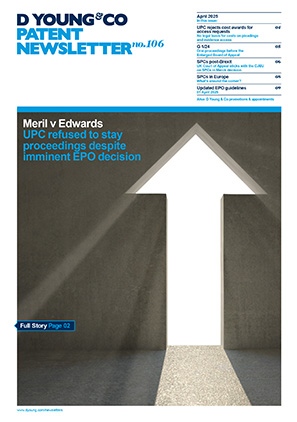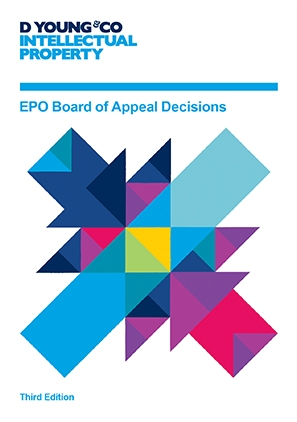Overview of the revised EPO Guidelines for Examination
The latest version of the Guidelines for Examination by the European Patent Office came into force on 01 March 2021. Here we discuss the key changes.
Oral proceedings
There are substantial updates regarding oral proceedings before the examining division or opposition division held by video conference (updates to parts C-VII, 5; D-VI, 3.2; E-III, 1, 2.2, 6 and 8; E-IV, 1.11.2).
As we have previously reported, all forthcoming examination and opposition oral proceedings will take place by video conference (ViCo), unless there are serious reasons preventing this. Sweeping objections against the reliability of ViCo technology or non-availability do not count.
Guide to Vico at the EPO
The EPO is moving towards the use of video conferencing (ViCo) as the “new normal” for oral proceedings. We have produced a guide drawing from our experience of ex parte and inter partes oral proceedings before the EPO by video conference to aid participants of such proceedings in what they might expect and how best to prepare. Our “Client Checklist for ViCo” is included for clients attending a ViCo hearing.
Read moreExamples of serious reasons against video conferencing include reasons relating to a participant to the oral proceedings as an individual (for example, a proven visual impairment preventing a representative from following oral proceedings on screen) or relating to the nature and subject-matter of proceedings (for example, involving the demonstration or inspection of objects where haptic features are essential).
There are also new subsections relating to remote connection, use of equipment and technology, checking the identity of parties present, and filing written submissions in oral proceedings by video conference.
As a reminder, the EPO also announced in December 2020 that appeal oral proceedings can be held by ViCo without consent of all parties (new Article 15a RPBA adopted by the Boards of Appeal Committee).
Changes relating to biotechnology
Multiple sections of the Guidelines (F-IV, 4.12, G-II, 5.2-5.5.1) have been updated to implement the Enlarged Board of Appeal decision of G 3/19 relating to products resulting from essentially biological processes.
G 3/19: plants produced by essentially biological processes are excluded from patentability
The Enlarged Board of Appeal has handed down its decision regarding the allowability of product and product-by-process claims in which the product is exclusively obtained by an essentially biological process.
Read moreFor example, it is now explicitly stated that the exclusion under Rule 28(2) regarding plants and animals exclusively obtained by means of an essentially biological process does not apply to patents granted before 01 July 2017 nor pending patent applications with a filing data and/or priority date before 01 July 2017.
In addition, the interpretation of the terms “identity” and “similarity” relating to amino acid or nucleic acid sequences has been clarified (F-IV, 4.24). For example, for amino acid sequences, if a percentage of homology is used by the applicant as the only feature to distinguish the subject-matter of a claim from the prior art, its use is objected to under Art. 84 (F-IV, 4.6.1) unless the determination or calculation of the percentage of homology is clearly defined in the application as filed.
In addition, a new section has been added relating to antibodies (G-II, 5.6), in particular clarifying how antibodies should be defined: for example, if by structure of the antibody, all six Complementarity-determining regions (CDRs) must be defined to fulfil the requirements of Article 84 EPC. Inventive step of antibodies is also addressed: antibodies binding a known antigen must have a surprising technical effect.
Changes relating to computer implemented inventions
There has been clarification concerning exclusions to user interfaces (G-II, 3.7.1): in particular, if technical considerations are involved to implement the linguistic model on a computer, such as those relating to the internal functioning of a computer, then a technical effect may arise.
There has also been clarification concerning exclusions to data retrieval, forms and structures (G-II, 3.6.3): a data structure only contributes to technical character of the invention if it produces a technical effect and cognitive data does not contribute to producing a technical effect.
There is a new section relating to database management systems and information retrieval (G-II, 3.6.4), which states that distinctions are made between executing structured queries by database management system, and information retrieval, and clarification regarding method steps defining additional devices (F-IV, 3.9.2). If not all features of the method claim are reflected in claims in other categories referring to said method, said claims in other categories have to be construed and examined separately, and if a step carried out by specific technical means cannot be carried out by generic data processing means an objection under Art. 84 EPC will normally be raised.
Non-unity
Sections relating to non-unity have been restructured and updated to converge with the practice of using a “minimum reasoning” (F-V, 2-3) when raising a non-unity objection. The minimum reasoning must outline at least: the common matter between groups of inventions, the reasons why this cannot provide a single general inventive concept, the reasons why there is no technical relationship between the remaining technical features of the different groups of claims, and a concluding statement that the requirements are not met.
Further procedural aspects
The section of the Guidelines for Examination relating to bringing the description into line with the claims has been updated extensively to clarify longstanding practice (B-XI, 3.7-3.8; C-II, 3.1-3.2; C-III, 2; C-VI, 1.1; F-II, 4.2; F-IV, 4.3; H-V, 2.7).
The amended guidelines emphasise that embodiments in the description no longer covered by the independent claims must be deleted, unless these embodiments can reasonably be considered to be useful for highlighting specific aspects of the amended claims. In these instances, the fact that an embodiment is not covered by the claims must be prominently stated (illustrative examples have been added). It is specifically noted that merely changing the word “invention” to “disclosure” and/or “embodiment” to “example”, “aspect” or similar is not sufficient for this purpose: it has to be explicitly specified that this part of the description does not describe part of the claimed invention.
In addition, subject-matter in the description being excluded from patentability needs to be excised, whether reworded such that it does not fall under exceptions or prominently marked as not being according to the claimed invention.
Finally, features required by the independent claims may not be described in the description as being optional using wording such as “preferably”, “may” or “optionally”. The description must be amended to remove such terms when preceding a feature of an independent claim.
It is now more important than ever that attorneys take time to carefully adapt the description to the allowed claims.
December 2020 EPO announcement
EPO announcement "Oral proceedings before the Boards of Appeal – continuation of the measures adopted due to the coronavirus (COVID-19) pandemic and revised practice on oral proceedings by VICO".
Read more
